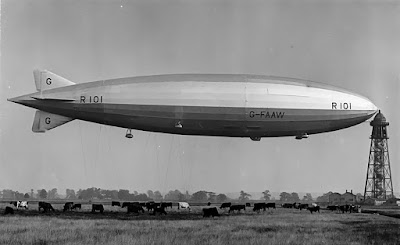The R101 airship was a grand and exciting project that ended in complete disaster for the British airship industry. It was championed by Lord Thomson, who was the Secretary of State for Air. The year was 1929 and the British Empire was still flourishing, though no one could for see that the huge Empire had only 15 to 20 years left – the forth coming World War II would see an end to such an age as the country would go bankrupt bravely surviving the ordeal along with many other great nations. Afterwards, the world would never be the same for Britain as she would be knocked off her high perch - the USA and USSR would become the new kids on the block for the coming age.
The R101 project was one of the last times when the Empire engaged on one of its grand adventures of improvement. The people of this time thought in a perspective of the Victorians – many of them had grown up during the reign – all they had known was Empire and their outlook was to build and be progressive on a grand scale. Among some of the Vickers engineers were Barnes Wallis of bouncing bomb fame and Nevil Shute, the famous novelist.
I feel the Labour MP and Peer, Lord Thomson (Champion of the R101 project) is not looked on in a good way, which I believe is wrong, because we all like to be wise after an event. The man tried to build a revolutionary travel route, which fell on the first hurdle and perhaps we feel smug looking back through history with the benefit of hindsight. I believe men of Lord Thomson's calibre deserve some credit, despite the failure of this grand endeavour. Men like him bring about great change, sometimes for good - sadly on this occasion it would not be. He was serving under Prime Minister Ramsay MacDonald's government from 1924 to his death in 1930.
I feel the Labour MP and Peer, Lord Thomson (Champion of the R101 project) is not looked on in a good way, which I believe is wrong, because we all like to be wise after an event. The man tried to build a revolutionary travel route, which fell on the first hurdle and perhaps we feel smug looking back through history with the benefit of hindsight. I believe men of Lord Thomson's calibre deserve some credit, despite the failure of this grand endeavour. Men like him bring about great change, sometimes for good - sadly on this occasion it would not be. He was serving under Prime Minister Ramsay MacDonald's government from 1924 to his death in 1930.
The R101 airship was completed at Cardington, Bedfordshire and she was the largest airship in the world. She made her first test flight in October 1929. The tests were unsatisfactory. The aircrew found the ship difficult to manoeuvre and she did not lift well. They tried to fix the problems and took her on more test flights. In 1930 she fell into an involuntary dive returning from an air show. The crew battled frantically to correct the colossal airship as she plunged nose first towards the ground for about 500 feet. The desperate crew managed to bring the airship under control, but only for a short duration because the ship fell into mini dives on two further occasions during the journey home.
Lord Thomson, the Air Secretary, had ambitions to use R101 as an air liner that would take people to and from India, the jewel of the Empire. He was determined that the giant airship be ready for the first flight to Karachi, then part of India. On route, there would be a stop in Egypt to gather fuel and further supplies for the rest of the journey. Lord Thomson was a very driven man and in many circumstances this is good when things need to be done. He had ambitions of starting an airship flight route to India on a regular basis. From there, maybe other air route services. The man might have had the makings of a pioneer, but the complex engineering that he was trying to rush through was very delicate indeed. He put a great deal of pressure on the engineers and because of this, there were not many test flights after the innovations and too much was left to chance. The first flight to India would commence on October 4th 1930.
The giant airship had a crew of 42 people to carry just 6 passengers and 6 officials. There were around 3,000 spectators watching the launch – the big adventure that would open a gateway to India, bringing the further parts of the British Empire closer to home. Again problems arose due to weight and ballast had to be dumped because of over loading. Also the aft engine broke down. Not a good start, but Lord Thomson, who was on board, was a man in a hurry. He needed to get the first foundation down in the achievement of a successful Britain to India flight.
They reached France and were just west of Paris when R101 fell into another dive. She was already flying low and the crew could not correct the airship’s decline on this dreadful occasion. The huge airship crashed and was engulfed in a fireball that took the lives of 48 people aboard R101, among them, Lord Thompson. Only 6 crew members survived the terrible crash. This was a national tragedy and brought an end to British Airship ventures.
.


















